
Wine Culture and Information since 2002 - Volume 22
 Wine Culture and Information since 2002 - Volume 22 |
|
Issue 215, March 2022 |
Contents |
|
|
The Letter F |
|
Let's make, for the umpteenth time, an obvious premise, repeating once again what everyone known for a very long time and that – now – is to be considered a bit like – by using a joke way of saying common in Italy – the discovery of warm water: the abuse of the consumption of ethyl alcohol is highly harmful to health. Let's add, therefore, a further premise, this too repeated several times and that everyone knows, without exception: the abuse of wine consumption is equally harmful to health. After all, I am not a doctor, I have no recognizable scientific competence allowing me to disprove these assertions – and of course, I always trust science and never chatters – therefore I accept them as true, reliable, truthful and, above all, verified and verifiable. Furthermore, science and research tell us that ethyl alcohol is not the only substance to be harmful to health, regardless of the abuse of consumption or not. Likewise, I think it is reasonable to believe anyone who appreciates and respects wine, as well as themselves, is aware of the fact that the abuse of alcohol is never healthy. In this regard, the proposal of the European Union to adopt the French system Nutri-Score for food labeling by 2022 is questionable and – recently – also suggested for drinks containing alcohol, wine included. For this specific category, in fact, it was even proposed the introduction of a new identifier marked with the letter F on a black background. It should be noted the Nutri-Score system provides for the marking of foods with an indicator consisting of the first five letters of the alphabet – from A to E – on colored backgrounds varying from green to red, as if it were a traffic light. The aim would be to quickly communicate the healthiness of the food: the identification with the letter A, on a green background, represents the maximum healthiness of the food in nutritional terms, the letter E, on a red background, an unhealthy food. In its definition and in the criterion of attribution of the “letters”, Nutri-Score is – in my opinion – rather questionable, not least, incomplete and confusing. The attribution of a letter, therefore the belonging to a specific nutritional category, is determined by the evaluation of some parameters and referred to 100 grams for food and 100 milliliters for drinks. Without going into the detailed specification of the method, a food having a high content of fruits, vegetables, fibers and proteins gets a high score, while the high energy content in kilo calories, sugar, saturated fatty acids and sodium, gives low scores. While one can appreciate the idea of offering a system capable of informing about the nutritional qualities of a food or drink, in reality its application is decidedly superficial and misleading. Let's consider a practical example with a widely used and common food, not only in Italy, but also in Europe: butter. One hundred grams of this food, notoriously, provides a very high supply of energy, and it is, for almost all of its composition, very rich in saturated fatty acids. These two qualities – alone – give butter, without appeal, the mark of the letter “E” on a red background. According to the Nutri-Score, butter is therefore a highly discouraged food, not least, absolutely unhealthy. By seeing a label marked with the letter E on a red background, every superficial consumer and, I would add, instinctively, is led to believe butter is an unhealthy food. That letter “E”, in fact, does not say the consumption of one hundred grams of butter is unhealthy: it merely superficially provides a misleading and incomplete information. It is assumed, implicitly, that even the consumption of a single gram of butter – or even less – is not healthy because the food is marked with the letter E. Let's frankly admit it: who would be willing – consciously – to eat one hundred grams of butter at once? Or to drink one hundred milliliters of olive oil – the equivalent of a little less than a glass – as, according to Nutri-Score, it is marked with the letter C, therefore classified in the middle of the scale of values, between the healthy and the harmful? Wine, moreover, was running a further and much more ignominious risk, that of being even marked with the letter F on a black background, thus classifying it as a highly harmful drink for health. Fortunately, the proposal to “mark” wine as highly harmful to health – and introduced by the so-called Cancer Plan – did not obtain the approval of the European Parliament. Wine, therefore, contrary to what was feared, will not be marked with the letter F on a black background. The European Parliament, in fact, rightly considered excessive the penalization that wine would have suffered as a consequence of this classification, also supporting the culture of moderate consumption. The result, it must be said, welcomes the requests and proposals of Italy, which has always been a supporter of the promotion and spreading of a culture of conscious and moderate consumption. In fact, the consumption of one or two glasses of wine cannot be compared to that of one or two bottles. The second measure, it does not certainly need an infamous black stamp to tell it, is clearly known to anyone as highly harmful and unequivocally unhealthy. Furthermore, exactly as it happens with the tobacco consumption awareness campaign, it is certainly not a stamp or a “warning” to discourage those who intend to abuse it. And the same, no doubt, is equally true for wine and alcoholic beverages. As far as wine is concerned, we will not therefore see the “gloomy” letter F in the labels and not even the nefarious warnings, something already appearing in the packaging of products containing tobacco. Instead, we will see recommendations for responsible and moderate consumption. A decidedly reasonable and acceptable solution, certainly in favor of raising awareness of moderate consumption, something that anyone who appreciates wine has always known. This does not evidently change the fundamental and indisputable consideration that alcohol abuse, regardless of the mode of consumption, is neither healthy nor wise. Personally, I have always believed the best form of prevention, applicable to any context or abuse, is always culture and education, civic sense and respect, for oneself and for others. I agree less with repressive measures as they are hardly effective in teaching anything truly useful other than to develop feelings of revolt and disobedience. Prohibition, introduced in the United States of America during the 1920s, is indeed a clear example of the evident ineffectiveness of a similar measure and its consequences. This does not obviously call into question the European Union initiative for the prevention of cancer and the promotion of healthy lifestyles: these are principles everyone supports and are wished by anyone. And prevention, no doubt, is achieved in particular with education and culture, as well as knowledge, research and evidence of the facts of social and healthy behaviors. For this reason, it is certainly not educational to equate moderate and conscious consumption of wine with its abuse. It is acceptable and indisputable to consider the abuse of alcoholic beverages to be harmful to health, even with very serious consequences. Likewise, it is harmful to health the excessive consumption of butter or sugar, as well as any other food. It is the dose making a poison, famously suggested by Paracelsus “omnia venenum sunt: nec sine veneno quicquam existit. Dosis sola facit, ut venenum non fit” and that is, “All things are poison, and nothing is without poison, the dosage alone makes it so a thing is not a poison.” This is true for wine as well as for any other food or drink. Antonello Biancalana
|
||||
Contrasts of Valtellina Rosso and Langhe NebbioloOne of the most important and famous Italian grapes compared in wines produced in the two main territories that best represent the great Nebbiolo: Langhe and Valtellina. |
|
Nebbiolo is one of the most popular and well-known varieties of Italy. A success that has not originated by chance, as from this grape are made among the greatest wines of Italy. Just think about Langhe in Piedmont: names such as Barolo, Barbaresco and Roero are known by any wine lover all over the world. Nebbiolo, however, is not Piedmont only and is – no less – Lombardy too, more specifically, the evocative and heroic territory of Valtellina, another great homeland of wines produced with this grape. Capable of creating memorable wines of powerful elegance, Nebbiolo is among the wine grape varieties to have one of the highest polyphenol content. A quality that is directly perceptible in its wines, notoriously characterized by a rather important astringent impact. Moreover, wines produced with Nebbiolo are also distinguished by their crispness – a quality given by acidity – which, combined with the astringency of tannins, creates a decidedly impressive gustatory profile. In this regard, it should be noted these characteristics – although they are perceptible in all wines produced with Nebbiolo – are strongly determined by environmental and climatic conditions, as well as by the composition of the soil. A clearly trivial consideration, as it is known to anyone how much these factors affect the organoleptic profile of wines, however in those produced with Nebbiolo the differences can become decidedly distant. This is what happens, in fact, for Nebbiolo wines produced in the Langhe and Valtellina: same grape, wines with a completely different personality. These differences are mainly determined by the specific environmental and climatic conditions existing in the respective territories, not least, by the clone used. As for the history of this grape – for the sake of completeness – according to many ampelographers it is native to Piedmont, however, according to some research done on the DNA of Nebbiolo, it would suggest Valtellina as its land of origin, therefore in Lombardy. Regardless of the dispute over the origin of the grape, the evident and indisputable fact is that, despite the place of cultivation and vinification, Nebbiolo is capable of creating wines of undisputed quality and value.
|
|
Valtellina is the undisputed kingdom of the Nebbiolo of the Alps. Historically and locally known by the name of Chiavennasca – to affirm its supposed origin in the territory of Valchiavenna, in the province of Sondrio – in this area Nebbiolo makes wines of extraordinary finesse and elegance. In this regard, it should be clarified the Nebbiolo found in Valtellina is a different clone from the one typically cultivated in the Langhe: it is therefore a different biotype, but always attributable to the Nebbiolo grape, with its own and unique characteristics, for this reason called the “Nebbiolo of the Alps”. Moreover, it should be noticed in Valtellina have been identified six different biotypes, all belonging to the Nebbiolo grape. Furthermore, it should be considered the particular environmental and climatic conditions of Valtellina – here the soil is mainly composed of sand and crumbled rock – with the result of making unique wines with an unmistakable character, characterized by a marked elegance and personality. In Valtellina are defined three areas, therefore wines, with denomination of controlled origin: Valtellina Superiore, Sforzato di Valtellina and Valtellina Rosso. The first two are classified as Denominazione d'Origine Controllata e Garantina (Denomination of Controlled and Guaranteed Origin, DOCG) while the red is recognized as DOC. Nebbiolo is the dominant variety which, according to the disciplinary, must be present for at least 90%, while the remaining part can be represented by red berried varieties allowed for cultivation in Lombardy. Valtellina Rosso – the wine we are examining in this month's tasting by contrast – must age for at least six months before being marketed, with no specific obligation for the type of container. Although the choice of producers is usually in favor of the cask, there are cases of Valtellina Rosso aged in steel tanks. As for the composition, although the disciplinary provides for the use of different grapes, in most cases this wine is produced exclusively with Nebbiolo. The result is generally a red wine of extreme agreeableness and finesse, very versatile in food pairing, with an olfactory profile decidedly oriented towards aromas belonging to the world of flowers.
|
||||
|
The wine making scenario of the Langhe, in the province of Cuneo, Piedmont, is totally different from that of Valtellina, near the Alps. Here too we have Nebbiolo – mainly Lampia and Michet clones – however the composition of the soil is completely different: here it is the clay to dominate the land. Substantial and fundamental differences, with the result of making wines, although with the same Nebbiolo grape, with a completely different character. Langhe – notoriously – are known all over the world for three red giants produced with Nebbiolo, specifically, Barolo, Barbaresco and Roero. In the Langhe – a territory recognized by the Italian quality system as a Denominazione d'Origine Controllata (Denomination of Controlled Origin, DOC) – Nebbiolo is in fact used in many wines, not least, for the production of mono-varietal wines, identified in the label with the name of the variety. In this regard – and as already mentioned several times in these pages – also in Langhe a wine can be defined as mono-varietal in case a variety is used for at least 85%. Langhe Nebbiolo is a certainly interesting wine and in which it is frequently possible to perceive the powerful character of the variety, sometimes even equaling the structure and character of the wines of the DOCG denominations, such as Barolo, Barbaresco and Roero. In this regard, it should be noted the Langhe denomination is decidedly large – if compared with those of the DOCGs found inside of it – and therefore the character of Langhe Nebbiolo can vary considerably due to the specific territory of the denomination in which it is produced. The choice of the clone – generally Lampia, Michet or both – also plays a decisive role in defining the sensorial qualities of Langhe Nebbiolo. To this must also be added the factor of aging, as the disciplinary provides for the use of both inert and wooden containers. All these variables and factors, understandably, make it possible to create Langhe Nebbiolo wines with very different sensorial qualities, while expressing – in any case – the character of both the variety and the denomination.
|
Before starting our tasting by contrast of Valtellina Rosso and Langhe Nebbiolo, let's first get the two bottles. These wines are readily available and it should not be difficult to find them, especially the Piedmontese wine. Although the majority of producers generally prefer to age these two wines in cask or in any case in wooden containers, our choice is preferably in favor of the vinification in inert containers, possibly the steel tank. Moreover, in both cases we will make sure the composition is represented exclusively by the Nebbiolo variety, while noticing – according to the respective production disciplinary – both Valtellina Rosso and Langhe Nebbiolo provide for the use of other varieties and allowed for cultivation in their respective regions. When choosing the two wines, we will also pay attention to the vintage, possibly belonging to the same harvest and no older than two years of aging. Valtellina Rosso and Langhe Nebbiolo are served at a temperature of 18 °C (64 °F) and poured into their respective tasting glasses. In the first phase of the sensorial evaluation of the two wines, we will examine appearance, that is how they appear to the eye in terms of color and transparency. The first wine we will evaluate is Valtellina Rosso and, by tilting the glass over a white surface, we observe the base, where the liquid mass is more consistent. The Lombard wine is characterized by a brilliant ruby red color and, by placing an object between the glass and the white surface, we can see a decidedly high transparency. Let's now evaluate the nuances of Valtellina Rosso, by observing the wine towards the opening of the glass, at the point where the liquid mass becomes thin. Also in this case, it is possible to see a ruby red color. Let's now pass to the evaluation of the appearance of Langhe Nebbiolo and, just like the previous wine, we tilt the glass over the white surface. The color of the Piedmontese wine is bright ruby red and, as for transparency, also in this case it is moderate, although it is lower than Valtellina Rosso. The nuance of Langhe Nebbiolo – observed towards the opening of the glass – confirms the base color, that is ruby red. The olfactory profiles of Valtellina Rosso and Langhe Nebbiolo, despite being produced with the same variety, differ in substantial and identifying characteristics. The factors responsible for these differences, in addition to the diversity of the Nebbiolo clones grown in the two territories, must be traced back to the environmental and climatic conditions of Valtellina and Langhe. The soil where the vineyards giving life to Valtellina Rosso are grown are in fact mainly composed of sand and crumbled rock, two qualities giving the wines both a paler color and an olfactory profile more oriented to the world of flowers. The condition of Langhe is quite different – here the presence of clay is dominant – which wines, in addition to generally having more intense colors, are characterized by an olfactory profile in which aromatic sensations are mainly referable to the world of fruits. In any case, we must consider both Valtellina Rosso and Langhe Nebbiolo are characterized by common aromas, specifically violet, rose and cyclamen – in regard to flowers – cherry, plum, raspberry and strawberry for the aromas belonging to the world of fruits. Let's continue this month's tasting by contrast and proceed with the evaluation of the olfactory profiles of Valtellina Rosso and Langhe Nebbiolo, starting – just like the previous phase – from the Lombard wine. Let's hold the glass in vertical position and, without swirling, let's do the first smell in order to appreciate the opening of the wine, that is its primary and identifying aromas. From the glass emerge – clean and intense – pleasing aromas of cherry, raspberry, violet and rose. Let's now swirl the glass, an operation favoring the development of the other aromas, and let's do another smell. The olfactory profile of Valtellina Rosso is completed with cyclamen, plum and strawberry. Let's move on to the evaluation of the opening of Langhe Nebbiolo, therefore – by holding the glass in vertical position and without swirling – let's proceed with the first smell. From the glass of Piedmontese wine can be perceived intense and clean aromas of cherry, plum and violet, a rather typical opening for Nebbiolo wines produced in the Langhe area. After having swirled the glass, the profile of the wine is completed with rose, blueberry and raspberry. We continue our tasting by contrast with the evaluation of the gustatory profiles of the two wines, examining the Valtellina Rosso first. Let's take a sip of the Lombard wine in order to evaluate its attack, that is the primary gustatory qualities perceived in the mouth at the first sip. The wine can be appreciated for its pleasing acidity – a typical characteristic of wines produced with Nebbiolo grapes – as well as for a moderate astringency, both being enough to balance the sensation of roundness, mainly produced by alcohol. In the mouth are clearly perceived flavors of cherry, raspberry and strawberry, confirming a good correspondence to the nose. Let's now pass to the evaluation of the attack of Langhe Nebbiolo and take a sip of this wine. In the mouth the Piedmontese wine can be appreciated, just like the previous one, for the pleasing sensation of crispness given by the acidity, in addition to the effect of tannins perceived in the astringency, the latter generally more intense than Valtellina Rosso. The sensation produced by alcohol is also more intense than Lombard wine, certainly essential for the balance of the greater strength of tannins. In the mouth we perceive flavors of cherry, raspberry and plum, also in this case confirming a good correspondence to the nose. We are about to end this month's tasting by contrast, therefore we will evaluate the final sensations the wines leave in the mouth after swallowing – in particular, the taste-olfactory persistence – by first examining Valtellina Rosso. The finish of this wine is persistent and in the mouth are still clearly perceptible the sensations of crispness given by the acidity and the moderate astringency of tannins: a decidedly elegant and refined finish. Moreover, we can clearly perceive flavors of cherry, raspberry and strawberry, qualities that we have already noted in the previous phases of the tasting. The finish of Langhe Nebbiolo is persistent and, also in this case, the sensations of acidity and astringency are clearly perceived in the mouth, the latter more intense than that of Valtellina Rosso. In the mouth are clearly perceived the flavors of cherry, plum and raspberry. Let's now place the two glasses side by side and let's proceed by taking a last smell. Note the differences in the two wines: Valtellina Rosso is more oriented towards sensations attributable to the world of flowers, while Langhe Nebbiolo is mainly characterized by aromas of red pulp fruits.
|
||||||||
Wines of the Month |
|
|
|
Score legend Prices are to be considered as indicative. Prices may vary according to the country or the shop where wines are bought |
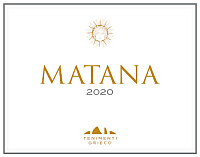
|
|
Matana 2020 |
|
| Tenimenti Grieco (Molise, Italy) | |
 Chardonnay Chardonnay | |
| Price: € 16.50 | Score: |
 Intense straw yellow and nuances of golden yellow, very transparent. Intense straw yellow and nuances of golden yellow, very transparent. Intense, clean, pleasing and refined, starts with hints of banana,
grapefruit and acacia followed by aromas of plum, citron, apple, pear,
praline, honey and vanilla. Intense, clean, pleasing and refined, starts with hints of banana,
grapefruit and acacia followed by aromas of plum, citron, apple, pear,
praline, honey and vanilla.
 Crisp attack and however balanced by alcohol, good body, intense
flavors, pleasing roundness. Crisp attack and however balanced by alcohol, good body, intense
flavors, pleasing roundness.
 Persistent finish with flavors of banana, plum and citron. Persistent finish with flavors of banana, plum and citron. A small part of the wine is fermented in barrique. 6 months in steel
tanks, 3 months in bottle. A small part of the wine is fermented in barrique. 6 months in steel
tanks, 3 months in bottle.
|
|
 Pasta with mushrooms and fish, Sauteed white meat, Broiled fish, Legume soups Pasta with mushrooms and fish, Sauteed white meat, Broiled fish, Legume soups |
|
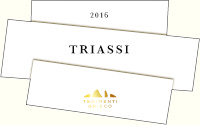
|
|
Triassi 2016 |
|
| Tenimenti Grieco (Molise, Italy) | |
 Cabernet Sauvignon (55%), Merlot (35%), Aglianico (10%) Cabernet Sauvignon (55%), Merlot (35%), Aglianico (10%) | |
| Price: € 24.50 | Score: |
 Intense ruby red and nuances of garnet red, little transparency. Intense ruby red and nuances of garnet red, little transparency. Intense, clean, pleasing, refined and elegant, starts with hints of
black cherry, plum and black currant followed by aromas dried violet,
blueberry, cocoa, leather, tobacco, licorice, mace, vanilla and eucalyptus. Intense, clean, pleasing, refined and elegant, starts with hints of
black cherry, plum and black currant followed by aromas dried violet,
blueberry, cocoa, leather, tobacco, licorice, mace, vanilla and eucalyptus.
 Properly tannic attack and however balanced by alcohol, full body,
intense flavors, pleasing roundness. Properly tannic attack and however balanced by alcohol, full body,
intense flavors, pleasing roundness.
 Persistent finish with flavors of black cherry, plum and black currant. Persistent finish with flavors of black cherry, plum and black currant. 21 months in barrique, 6 months in bottle. 21 months in barrique, 6 months in bottle. |
|
 Game, Roasted meat, Stewed and braised meat, Hard cheese Game, Roasted meat, Stewed and braised meat, Hard cheese |
|
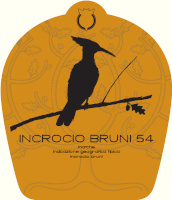
|
|
Incrocio Bruni 54 2020 |
|
| Terracruda (Marches, Italy) | |
 Incrocio Bruni 54 Incrocio Bruni 54 | |
| Price: € 11.90 | Score: |
 Brilliant straw yellow and nuances of greenish yellow, very
transparent. Brilliant straw yellow and nuances of greenish yellow, very
transparent.
 Intense, clean, pleasing and refined, starts with hints of peach, pear
and elder flower followed by aromas of hawthorn, kiwi, citrus fruits,
pineapple, apple, grapefruit, plum and nettle. Intense, clean, pleasing and refined, starts with hints of peach, pear
and elder flower followed by aromas of hawthorn, kiwi, citrus fruits,
pineapple, apple, grapefruit, plum and nettle.
 Crisp attack and however balanced by alcohol, good body, intense
flavors, agreeable. Crisp attack and however balanced by alcohol, good body, intense
flavors, agreeable.
 Persistent finish with flavors of peach, pear and kiwi. Persistent finish with flavors of peach, pear and kiwi. Aged in steel tanks. Aged in steel tanks. |
|
 Pasta with dish and crustaceans, Sauteed fish, Sauteed white meat, Fried fish, Dairy products Pasta with dish and crustaceans, Sauteed fish, Sauteed white meat, Fried fish, Dairy products |
|
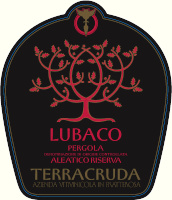
|
|
Pergola Aleatico Riserva Lubaco 2016 |
|
| Terracruda (Marches, Italy) | |
 Aleatico Aleatico | |
| Price: € 37.50 | Score: |
 Intense ruby red and nuances of ruby red, little transparency. Intense ruby red and nuances of ruby red, little transparency. Intense, clean, pleasing, refined and elegant, starts with hints of
black cherry, plum and blackberry followed by aromas of dried violet, rose,
raspberry, cocoa, tobacco, leather, cinnamon, mace, licorice, vanilla and
menthol. Intense, clean, pleasing, refined and elegant, starts with hints of
black cherry, plum and blackberry followed by aromas of dried violet, rose,
raspberry, cocoa, tobacco, leather, cinnamon, mace, licorice, vanilla and
menthol.
 Properly tannic attack and however balanced by alcohol, good body,
intense flavors, agreeable. Properly tannic attack and however balanced by alcohol, good body,
intense flavors, agreeable.
 Persistent finish with flavors of plum, black cherry and blackberry. Persistent finish with flavors of plum, black cherry and blackberry. 18 months in barrique, 18 months in bottle. 18 months in barrique, 18 months in bottle. |
|
 Roasted meat, Stewed meat with mushrooms, Cheese Roasted meat, Stewed meat with mushrooms, Cheese |
|
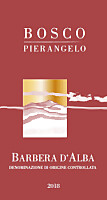
|
|
Barbera d'Alba 2018 |
|
| Bosco Pierangelo (Piedmont, Italy) | |
 Barbera Barbera | |
| Price: € 13.00 | Score: |
 Intense ruby red and nuances of ruby red, little transparency. Intense ruby red and nuances of ruby red, little transparency. Intense, clean, pleasing and refined, starts with hints of cherry, plum
and violet followed by aromas of blueberry, chocolate, tobacco, pink
pepper, cinnamon, mace, vanilla and menthol. Intense, clean, pleasing and refined, starts with hints of cherry, plum
and violet followed by aromas of blueberry, chocolate, tobacco, pink
pepper, cinnamon, mace, vanilla and menthol.
 Properly tannic attack and however balanced by alcohol, good body,
intense flavors, pleasing crispness. Properly tannic attack and however balanced by alcohol, good body,
intense flavors, pleasing crispness.
 Persistent finish with flavors of cherry, plum and blueberry. Persistent finish with flavors of cherry, plum and blueberry. 4 months in cask. 4 months in cask. |
|
 Stuffed pasta with meat and mushrooms, Broiled meat and barbecue, Roasted meat, Stewed meat with mushrooms Stuffed pasta with meat and mushrooms, Broiled meat and barbecue, Roasted meat, Stewed meat with mushrooms |
|
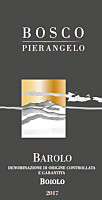
|
|
Barolo Boiolo 2017 |
|
| Bosco Pierangelo (Piedmont, Italy) | |
 Nebbiolo Nebbiolo | |
| Price: € 35.00 | Score: |
 Brilliant ruby red and nuances of garnet red, moderate transparency. Brilliant ruby red and nuances of garnet red, moderate transparency. Intense, clean, pleasing, refined and elegant, starts with hints of
cherry, plum and dried violet followed by aromas of dried rose, raspberry,
blueberry, cinnamon, tobacco, cocoa, licorice, mace, vanilla and menthol. Intense, clean, pleasing, refined and elegant, starts with hints of
cherry, plum and dried violet followed by aromas of dried rose, raspberry,
blueberry, cinnamon, tobacco, cocoa, licorice, mace, vanilla and menthol.
 Tannic attack and however balanced by alcohol, full body, intense
flavors, pleasing crispness. Tannic attack and however balanced by alcohol, full body, intense
flavors, pleasing crispness.
 Persistent finish with flavors of cherry, plum and raspberry. Persistent finish with flavors of cherry, plum and raspberry. 24 months in cask. 24 months in cask. |
|
 Game, Roasted meat, Braised and stewed meat, Cheese Game, Roasted meat, Braised and stewed meat, Cheese |
|
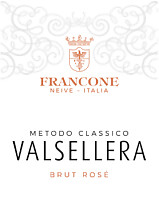
|
|
Valsellera Brut Rosé |
|
| Francone (Piedmont, Italy) | |
 Nebbiolo Nebbiolo | |
| Price: € 20.00 | Score: |
 Pale cherry pink and nuances of onion skin pink, transparent, fine and
persistent perlage. Pale cherry pink and nuances of onion skin pink, transparent, fine and
persistent perlage.
 Intense, clean, pleasing and refined, starts with hints of cherry,
raspberry and bread crust followed by aromas of rose, cyclamen, tangerine,
strawberry, plum, apple and hazelnut. Intense, clean, pleasing and refined, starts with hints of cherry,
raspberry and bread crust followed by aromas of rose, cyclamen, tangerine,
strawberry, plum, apple and hazelnut.
 Effervescent and crisp attack, however balanced by alcohol, good body,
intense flavors, agreeable. Effervescent and crisp attack, however balanced by alcohol, good body,
intense flavors, agreeable.
 Persistent finish with flavors of cherry, raspberry and tangerine. Persistent finish with flavors of cherry, raspberry and tangerine. Refermented in bottle and aged on its lees for 18 months. Refermented in bottle and aged on its lees for 18 months. |
|
 Pasta with mushrooms, Roasted fish, Sauteed white meat, Mushroom soups Pasta with mushrooms, Roasted fish, Sauteed white meat, Mushroom soups |
|
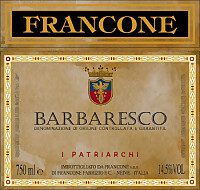
|
|
Barbaresco I Patriarchi 2018 |
|
| Francone (Piedmont, Italy) | |
 Nebbiolo Nebbiolo | |
| Price: € 21.00 | Score: |
 Brilliant ruby red and nuances of garnet red, moderate transparency. Brilliant ruby red and nuances of garnet red, moderate transparency. Intense, clean, pleasing and refined, starts with hints of cherry, plum
and raspberry followed by aromas of violet, rose, cinnamon, chocolate,
tobacco, vanilla and menthol. Intense, clean, pleasing and refined, starts with hints of cherry, plum
and raspberry followed by aromas of violet, rose, cinnamon, chocolate,
tobacco, vanilla and menthol.
 Tannic attack and however balanced by alcohol, full body, intense
flavors, pleasing crispness. Tannic attack and however balanced by alcohol, full body, intense
flavors, pleasing crispness.
 Persistent finish with flavors of cherry, plum and raspberry. Persistent finish with flavors of cherry, plum and raspberry. 30 months in cask. 30 months in cask. |
|
 Game, Stewed and braised meat with mushrooms, Roasted meat, Hard cheese Game, Stewed and braised meat with mushrooms, Roasted meat, Hard cheese |
|
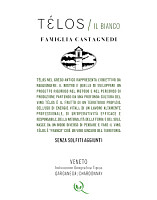
|
|
Telos Il Bianco 2020 |
|
| Tenuta Sant'Antonio (Veneto, Italy) | |
 Garganega (80%), Chardonnay (20%) Garganega (80%), Chardonnay (20%) | |
| Price: € 18.00 | Score: |
 Intense golden yellow and nuances of golden yellow, very transparent. Intense golden yellow and nuances of golden yellow, very transparent. Intense, clean, pleasing and refined, starts with hints of apple, plum
and hawthorn followed by aromas of broom, elder flower, peach, citrus
fruits, banana, rosemary and almond. Intense, clean, pleasing and refined, starts with hints of apple, plum
and hawthorn followed by aromas of broom, elder flower, peach, citrus
fruits, banana, rosemary and almond.
 Crisp attack and however balanced by alcohol, good body, intense
flavors, pleasing roundness. Crisp attack and however balanced by alcohol, good body, intense
flavors, pleasing roundness.
 Persistent finish with flavors of apple, plum and peach. Persistent finish with flavors of apple, plum and peach. Aged in steel tanks. Aged in steel tanks. |
|
 Pasta with fish and crustaceans, Stewed fish, Mushroom soups, Sauteed white meat Pasta with fish and crustaceans, Stewed fish, Mushroom soups, Sauteed white meat |
|
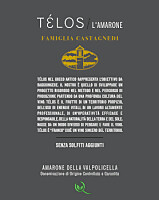
|
|
Amarone della Valpolicella Telos 2016 |
|
| Tenuta Sant'Antonio (Veneto, Italy) | |
 Corvina (70%), Rondinella (20%), Croatina (5%), Oseleta (5%) Corvina (70%), Rondinella (20%), Croatina (5%), Oseleta (5%) | |
| Price: € 45.00 | Score: |
 Deep ruby red and nuances of garnet red, little transparency. Deep ruby red and nuances of garnet red, little transparency. Intense, clean, pleasing, refined and elegant, starts with hints of
plum, blackberry and dried violet followed by aromas of black cherry,
blueberry, tamarind, carob, tobacco, cocoa, coffee, licorice, vanilla and
menthol. Intense, clean, pleasing, refined and elegant, starts with hints of
plum, blackberry and dried violet followed by aromas of black cherry,
blueberry, tamarind, carob, tobacco, cocoa, coffee, licorice, vanilla and
menthol.
 Properly tannic attack and however balanced by alcohol, full body,
intense flavors, pleasing roundness. Properly tannic attack and however balanced by alcohol, full body,
intense flavors, pleasing roundness.
 Persistent finish with flavors of plum, blackberry and black cherry. Persistent finish with flavors of plum, blackberry and black cherry. 16 months in cask. 16 months in cask. |
|
 Game, Roasted meat, Stewed and braised meat, Hard cheese Game, Roasted meat, Stewed and braised meat, Hard cheese |
|
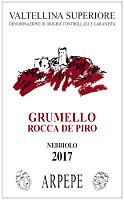
|
|
Valtellina Superiore Grumello Rocca de Piro 2017 |
|
| Ar.Pe.Pe. (Lombardy, Italy) | |
 Nebbiolo Nebbiolo | |
| Price: € 30.00 | Score: |
 Brilliant ruby red and nuances of garnet red, moderate transparency. Brilliant ruby red and nuances of garnet red, moderate transparency. Intense, clean, pleasing, refined and elegant, starts with hints of
cherry, plum and violet followed by aromas of rose, raspberry, cinnamon,
tobacco, cocoa, leather, licorice, thyme, vanilla and menthol. Intense, clean, pleasing, refined and elegant, starts with hints of
cherry, plum and violet followed by aromas of rose, raspberry, cinnamon,
tobacco, cocoa, leather, licorice, thyme, vanilla and menthol.
 Tannic attack and however balanced by alcohol, full body, intense
flavors, pleasing crispness. Tannic attack and however balanced by alcohol, full body, intense
flavors, pleasing crispness.
 Persistent finish with flavors of cherry, plum and raspberry. Persistent finish with flavors of cherry, plum and raspberry. 12 months in cask and cement tanks. 12 months in cask and cement tanks. |
|
 Game, Roasted meat, Stewed and braised meat with mushrooms Game, Roasted meat, Stewed and braised meat with mushrooms |
|
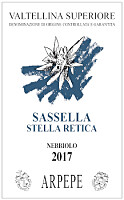
|
|
Valtellina Superiore Sassella Stella Retica 2017 |
|
| Ar.Pe.Pe. (Lombardy, Italy) | |
 Nebbiolo Nebbiolo | |
| Price: € 30.00 | Score: |
 Brilliant ruby red and nuances of brick red, moderate transparency. Brilliant ruby red and nuances of brick red, moderate transparency. Intense, clean, pleasing, refined and elegant, starts with hints of
cherry, raspberry and dried violet followed by aromas of dried rose,
cyclamen, strawberry, plum, cinnamon, chocolate, leather, licorice, mace,
rosemary, thyme, vanilla and menthol. Intense, clean, pleasing, refined and elegant, starts with hints of
cherry, raspberry and dried violet followed by aromas of dried rose,
cyclamen, strawberry, plum, cinnamon, chocolate, leather, licorice, mace,
rosemary, thyme, vanilla and menthol.
 Properly tannic attack and however balanced by alcohol, full body,
intense flavors, pleasing crispness. Properly tannic attack and however balanced by alcohol, full body,
intense flavors, pleasing crispness.
 Very persistent finish with long flavors of cherry, raspberry and plum. Very persistent finish with long flavors of cherry, raspberry and plum. 12 months in cask and cement tanks. 12 months in cask and cement tanks. |
|
 Game, Roasted meat, Stewed and braised meat with mushrooms, Cheese Game, Roasted meat, Stewed and braised meat with mushrooms, Cheese |
|
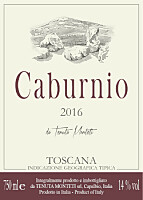
|
|
Caburnio 2016 |
|
| Tenuta Monteti (Tuscany, Italy) | |
 Cabernet Sauvignon (60%), Alicante Bouschet (25%), Merlot (15%) Cabernet Sauvignon (60%), Alicante Bouschet (25%), Merlot (15%) | |
| Price: € 19.00 | Score: |
 Intense ruby red and nuances of garnet red, little transparency. Intense ruby red and nuances of garnet red, little transparency. Intense, clean, pleasing, refined and elegant, starts with hints of
black currant, plum and black cherry followed by aromas of dried violet,
blueberry, cocoa, tobacco, leather, juniper, licorice, vanilla and
eucalyptus. Intense, clean, pleasing, refined and elegant, starts with hints of
black currant, plum and black cherry followed by aromas of dried violet,
blueberry, cocoa, tobacco, leather, juniper, licorice, vanilla and
eucalyptus.
 Properly tannic attack and however balanced by alcohol, good body,
intense flavors, agreeable. Properly tannic attack and however balanced by alcohol, good body,
intense flavors, agreeable.
 Persistent finish with flavors of black currant, plum and black cherry. Persistent finish with flavors of black currant, plum and black cherry. 12 months in steel tanks, barrique and cask, 12 months in bottle. 12 months in steel tanks, barrique and cask, 12 months in bottle. |
|
 Broiled meat and barbecue, Roasted meat, Stewed meat with mushrooms, Hard cheese Broiled meat and barbecue, Roasted meat, Stewed meat with mushrooms, Hard cheese |
|
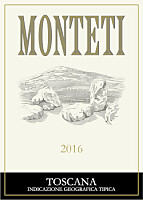
|
|
Monteti 2016 |
|
| Tenuta Monteti (Tuscany, Italy) | |
 Petit Verdot (50%), Cabernet Franc (30%), Cabernet Sauvignon (20%) Petit Verdot (50%), Cabernet Franc (30%), Cabernet Sauvignon (20%) | |
| Price: € 42.00 | Score: |
 Deep ruby red and nuances of garnet red, little transparency. Deep ruby red and nuances of garnet red, little transparency. Intense, clean, pleasing, refined and elegant, starts with hints of
black currant, black cherry and plum followed by aromas of dried violet,
blueberry, blackberry, cocoa, tobacco, leather, tar, licorice, mace, bell
pepper, vanilla and eucalyptus. Intense, clean, pleasing, refined and elegant, starts with hints of
black currant, black cherry and plum followed by aromas of dried violet,
blueberry, blackberry, cocoa, tobacco, leather, tar, licorice, mace, bell
pepper, vanilla and eucalyptus.
 Properly tannic attack and however balanced by alcohol, full body,
intense flavors, agreeable. Properly tannic attack and however balanced by alcohol, full body,
intense flavors, agreeable.
 Very persistent finish with long flavors of black currant, black cherry
and plum. Very persistent finish with long flavors of black currant, black cherry
and plum.
 18 months in barrique, 24 months in bottle. 18 months in barrique, 24 months in bottle. |
|
 Game, Roasted meat, Stewed and braised meat, Cheese Game, Roasted meat, Stewed and braised meat, Cheese |
|
News |
|
In this section are published news and information about events concerning the world of wine and food. Whoever is interested in publishing this kind of information can send us a mail to our address.
|
AquavitaeReview of Grappa, Distillates and Brandy |
|
|
||||||||||||
Wine Guide ParadeNovember 2021
|
| |||||||
Privacy Policy | |||||||


| Copyright © 2002-2024 Antonello Biancalana, DiWineTaste - All rights reserved |
| All rights reserved under international copyright conventions. No part of this publication and of this WEB site may be
reproduced or utilized in any form or by any means, electronic or mechanical, without permission in writing from DiWineTaste. |